
How Stephen Gould Scaled Its Capacity by 30% without Making a Single Hire
You want a high-performing team? That's completely within your reach. Taking the right steps to it however involves a bit more of a strategy. Read on to see what we mean.
Executive Summary:
You want a high-performing team? That's completely within your reach. Taking the right steps to it however involves a bit more of a strategy. Read on to see what we mean.
Nothing drives a company forward more effectively than a close-knit, well-adjusted, and high-performing team.
So creating such a team must be at the forefront of any manager’s strategy. The benefits you get from it include:
So knowing this, there is no question of if – only how.
A high-performing team is generally a goal-focused team that is highly collaborative, innovative, and data-driven. Such a team has shared goals and values and clear roles within itself, with a strong focus on trust and ownership among its members. Producing extraordinary results is the product of a high-performing team, but it’s not the only characterization. These factors should also be present:
High-performing teams, of course, have challenges and issues like any other team. The difference is what tools they use to cope and in which direction they choose to focus their efforts, staying consistent in any environment and project.
Creating a high-performing team could be the solution for a tendency for lower results and productivity. Finding the mechanisms to pursue, develop and sustain such a team is invaluable for any department.
To see exactly how to do that, let’s look at the seven characteristics of high-performance teams.
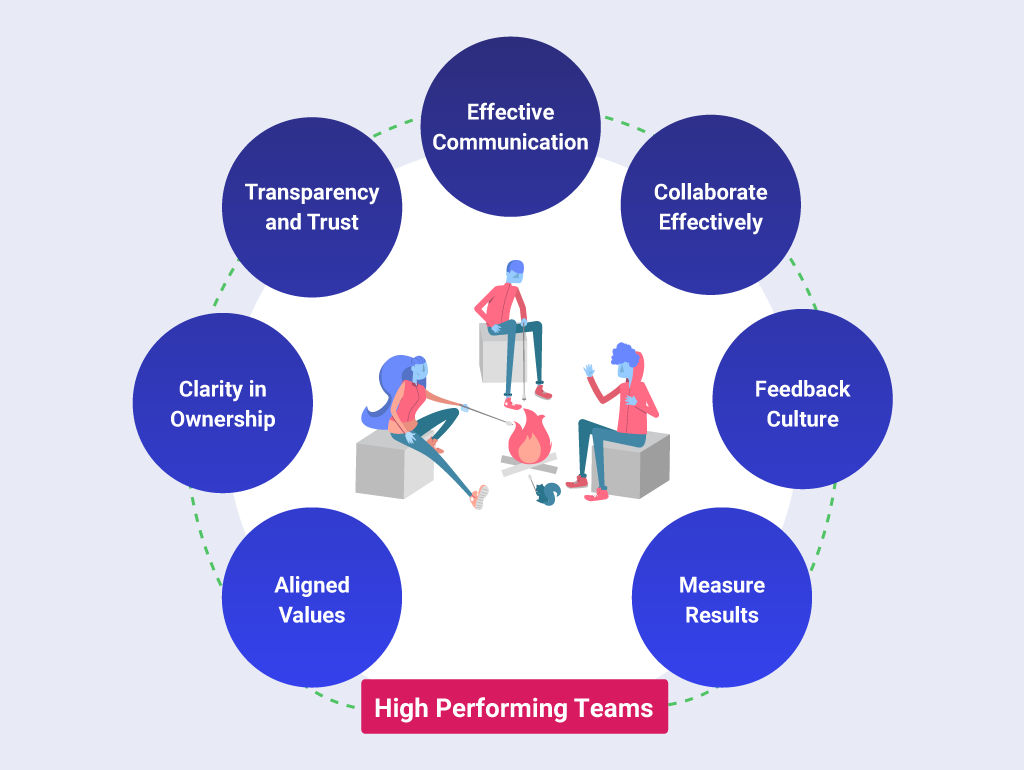
“Coming together is a beginning. Keeping together is progress. Working together is a success.” – Henry Ford
To build an effective team you can call high-performing, you first need to understand the characteristics of it in depth and work towards creating it while keeping an eye on them. There are factors that need to be present for the team to be organized in a way that not only creates a bond between them but lets them interact freely and always be aware of what every member is always doing. That way projects are always on time; performance is harmonious and productivity – increased in a great measure. Here are the seven characteristics that you need to have present to say you have a high-performing team.
In a team, everyone should know what the vision is and strive to keep their work aligned with that vision. A high-performing team must have the same values, purpose, and common objective to deliver the best business results.
In a team, everyone has their title, but it is important to also have clarity on roles so that all pieces of the puzzle fit together. Learning what your team members’ individual strengths are is key here. That way, everyone can contribute in their own unique way and everyone on the team is clear on where they stand in a particular project, what is expected to be delivered, and by whom.
In an effective team, everyone should have accountability, ownership, and clarity in their tasks. Trust is built through communication, transparency, and having all the information on progress and potential issues or blockers for assignments.
Keeping each other in the loop about everything is invaluable especially in our day and age when remote teams, distributed teams, and digital workspaces seem to have become the norm for many a business. Let your team communicate freely and frequently, in groups and individually, and always in context. This highly depends on the chosen channel, but also on the company’s attitude and values they instill in their team, to always keep each other informed and not be afraid to speak up.
A team is a group of people that should always exchange ideas, knowledge, and opinions. This provides inevitable strength in going forward since collaboration is the saving grace for any potential hurdles. Different perspectives and exchange of views lead to delivering the best possible solution.
High-performing teams thrive on feedback – when it’s presented in the correct way and with valid arguments. Teams enjoy exploring new territories, but they also need course-correcting sometimes and experienced team members can provide that. Creating a culture of feedback among all team members, no matter their rank is one of the best characteristics of high-performing teams, leading to higher performance.
It’s the data-driven approach that makes the difference for high-performing teams. Try and always measure the outcomes, good and bad, to see the right direction to step in next and encourage your team to stay on the right track. Keeping an eye on successful outcomes that deserve praise and not-so-great ones that need to be improved upon with new ideas.
Organizing your team around the concept of high-performance can transform your organization for the better. Benefits for the company as a whole are indisputable, but what’s the breakdown of the advantages of building this kind of team and depending on them for increased productivity.
We can divide the benefits of high-performing teams in two directions – one for employees and one for the company.
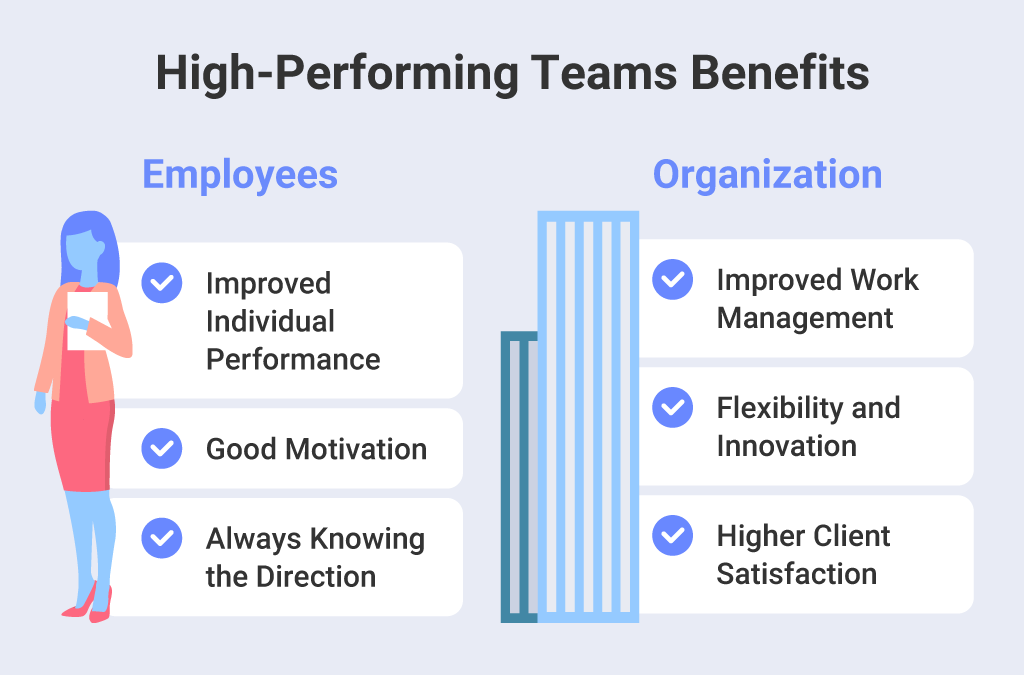
One thing is for sure: with high-performing teams, any company has the opportunity to develop better flexibility, learn the power of shared opinion, and have hard work rewarded with quick adaptation to any circumstance.
In today’s quickly changing and competitive business world, knowing how to build a high-performing team is crucial. Developing the people in the team to use their best abilities, nurture their skills and create a close-knit unit that functions as one always pays off in the form of success and met goals. But what are the steps to building a high-performing team? Here is an outline of the most important ones.
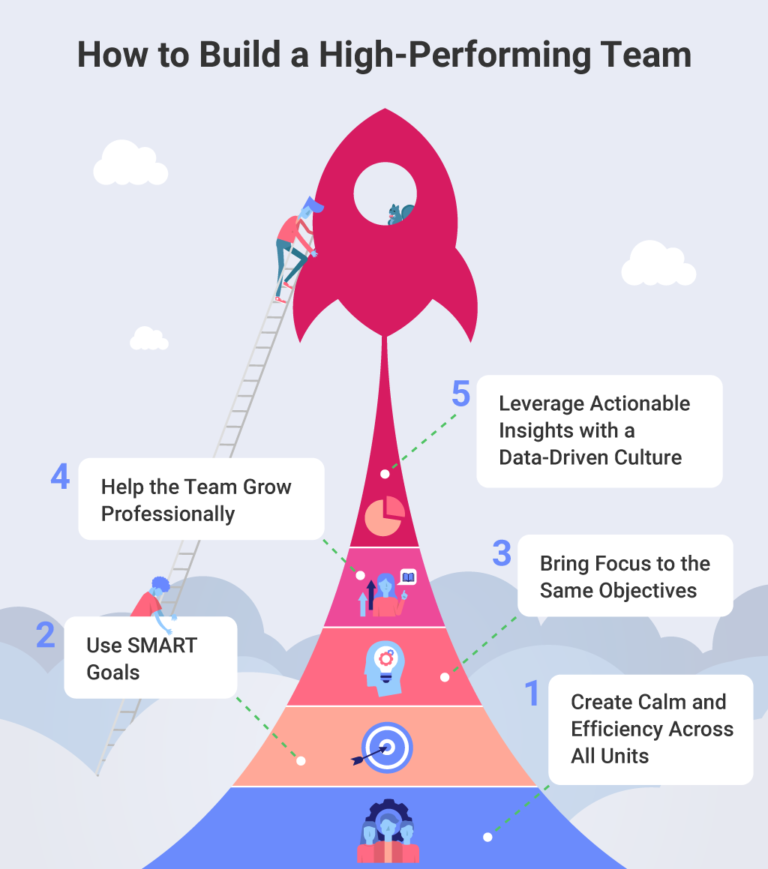
Between your team members, there must be common objectives, vision, and goals, but even more important than that is the unity in collaboration. Therefore, the first step is building a culture of collaboration across teams, departments and even with external clients, so that everything is unified daily.
High-performing teams always stay on top of the objectives and the way to make sure they are consistent and lead to success is to use SMART goals, set them, and keep your team’s focus on the key priorities. The SMART goals methodology is closely connected to creating a high-performing team.
Never let your team disconnect – a high-performing team should collaborate efficiently and have a channel for communication in context, to promote engagement with each other, brainstorming, and connection beyond the purely operational discussions. Align your team on the same objectives and strategies. If there are physical barriers to effective communication, make sure to remove them, through digital workspaces or other methods of work. Set processes that prevent miscommunication and ensure key information is never lost, assignments and tasks stay on point, and everything is trackable.
It’s always a good idea to foster a culture of learning and improvement, helping your team to improve on their knowledge. Development opportunities and individual goals should be supported, nurtured with the support of the company, so employees are always best equipped to do their jobs and grow professionally.
Treating data as the central source of insight for any choice at any level and department is key. When everyone in your team knows that relying on data is the strategy, they start using that approach in their daily routine and everything falls into place. It brings transparency to the whole enterprise and helps provide easily consumable insights that can help you control the narrative with ease. Data is set to become the path for change for many businesses and opening new doors to smart strategies ahead.
Seamlessly manage tasks, teams, and projects of any complexity from start to finish.
Use Template →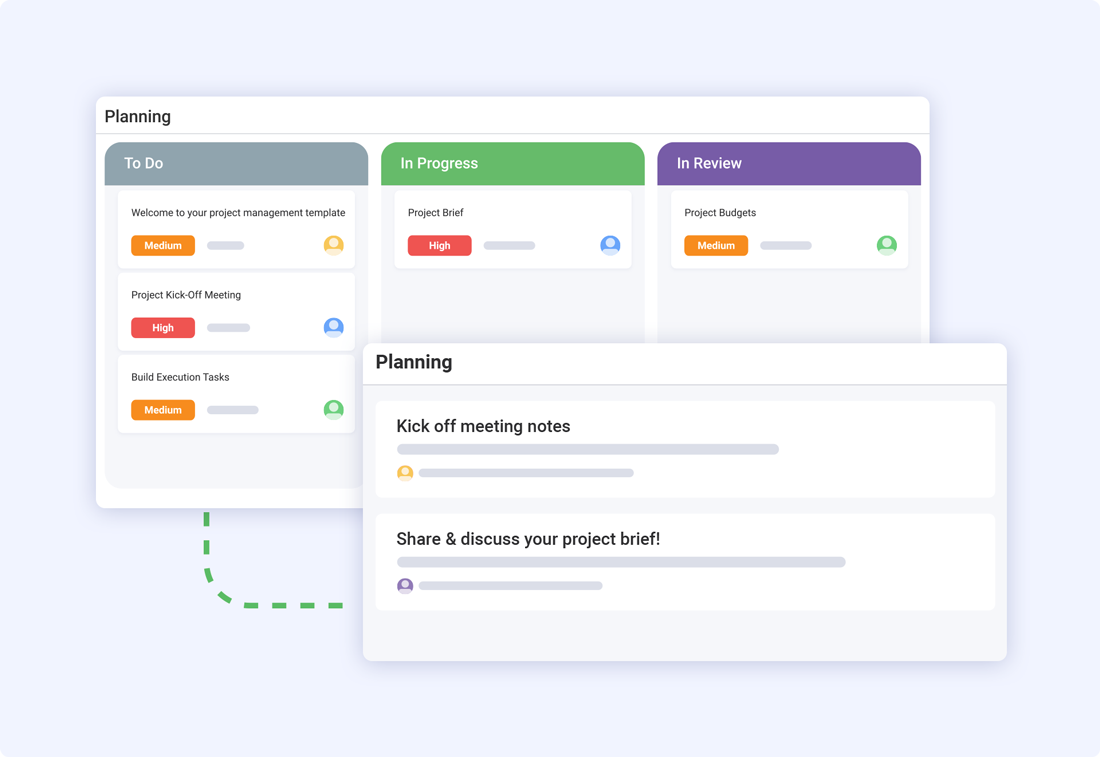
Every team starts with the basic perception that all the people in it must be of “the same blood type” – meaning, they get along great and thus work together in perfect flow. It is not so much a question of character although it is important, but of instilling the right processes and methods of work that are the catalyst for increasingly great results. High-performing teams could be any type, and they all have specific things to focus on. Let’s take a look at the examples of teams you always want to be high-performing. Teams that have place in every company no matter the size or the industry, including startups.
The marketing team is the one that generates ideas, supports sales, and executes campaigns. So for this team to be high-performing, you need to provide a way to track data, collaborate, store ad copy and creative, manage events, look at data insights and take action quickly and based on precise analysis. Having a constant overview of the workflow and progress, transparency of tasks and ownership produces fast results. Also, all creative assets are gathered in one place, so you can always find the most updated content piece or a visual.
These are the teams that always need to have a space to have relevant discussions on a project. Leading the process ahead depends on staying on point with communication and carrying the necessary weight when it comes to making decisions, brainstorming, and going forward creatively and strategically.
As one of the backbones of any business, the sales team also needs to stay high-performing, and here, you cannot underestimate the power of data. Providing information and insights without requiring the need for deeper understanding or expertise by the users is powerful since data generates valuable knowledge of what has been, what comes next, and what strategy to take.
Teams that provide a service or develop a product need to have clear directions, trackable processes, ability to use a way of work that implements a method to help your team’s processes while finding the process that works best for your use case. Traditionally, such a team needs an environment that has clear priorities and due dates, with a roadmap of everything that has or needs to be done.
Here are some of the features offered by Slingshot that can help you build your high-performing team through an all-in-one app.
Slingshot has a chat function that runs both on a task level and in context, group chat and 1-1, so nothing gets lost. You can also assign tasks directly from a chat, so no idea is ever lost.
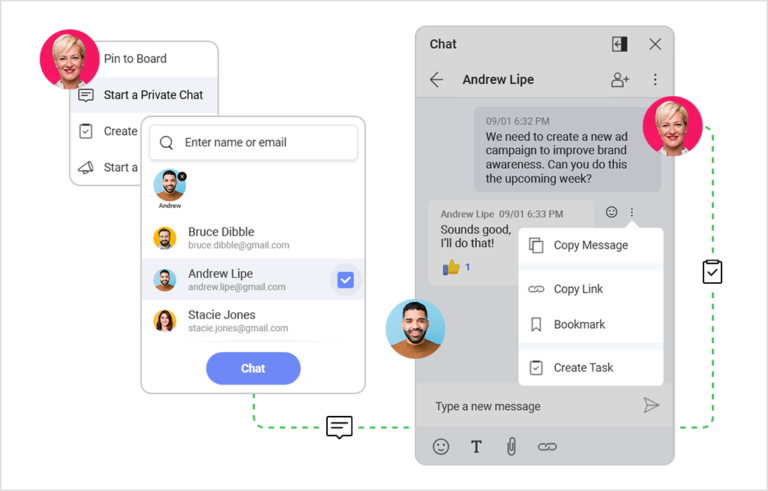
Slingshot has every project’s assets/communications in one place with limited access to the specific project or workspace.
As aproject management and collaboration software, Slingshot works as a planning tool for the team, helping with ownership, and distribution of tasks and tracking the progress of everything.![]()
A good productivity flow contributes to a team’s success as well as to the organization’s overall growth. Slingshot removes the hurdles that can hurt the progress of a project by eliminating the constant app switching and providing data analytics, project and information management, chat, and goals-based strategy benchmarking – all in one app.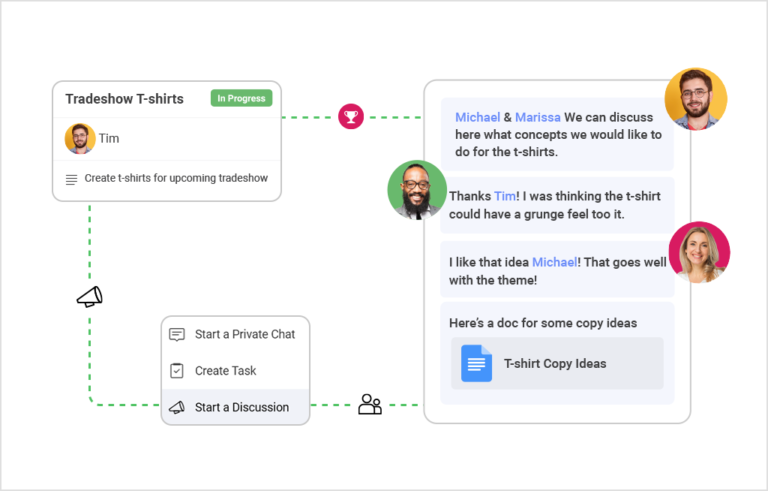
In Slingshot, various teammates collaborate with ease, to combine their unique functions – designers, developers, etc. While creating a content piece ready for publishing, all these people can collaborate in one app, keep all assets updated and pin the important files on best practices.
Slingshot offers data-driven features that help you visualize the data and easily share it with both your internal and external team, to keep everyone in the loop
Within every Slingshot task, there is always a timeline of the whole process from start to finish, all files available, brief, discussions, and clear directions all in one place, with no need for multiple iterations
Are you ready to take your team to the highest performance?
SHARE THIS POST